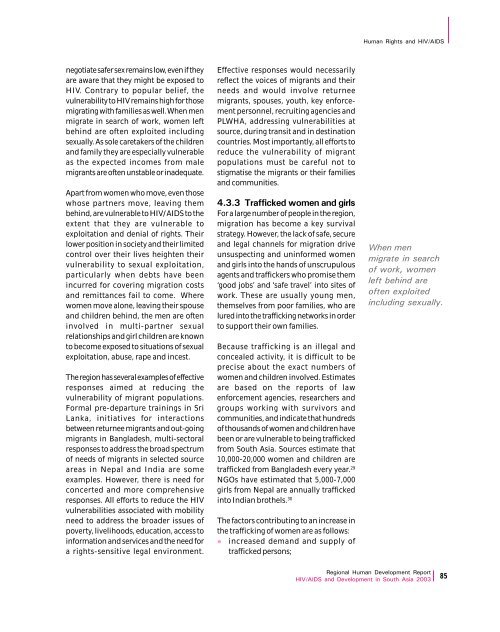Download Report - UNDP Asia-Pacific Regional Centre - United ...
Download Report - UNDP Asia-Pacific Regional Centre - United ...
Download Report - UNDP Asia-Pacific Regional Centre - United ...
Create successful ePaper yourself
Turn your PDF publications into a flip-book with our unique Google optimized e-Paper software.
Human Rights and HIV/AIDSnegotiate safer sex remains low, even if theyare aware that they might be exposed toHIV. Contrary to popular belief, thevulnerability to HIV remains high for thosemigrating with families as well. When menmigrate in search of work, women leftbehind are often exploited includingsexually. As sole caretakers of the childrenand family they are especially vulnerableas the expected incomes from malemigrants are often unstable or inadequate.Apart from women who move, even thosewhose partners move, leaving thembehind, are vulnerable to HIV/AIDS to theextent that they are vulnerable toexploitation and denial of rights. Theirlower position in society and their limitedcontrol over their lives heighten theirvulnerability to sexual exploitation,particularly when debts have beenincurred for covering migration costsand remittances fail to come. Wherewomen move alone, leaving their spouseand children behind, the men are ofteninvolved in multi-partner sexualrelationships and girl children are knownto become exposed to situations of sexualexploitation, abuse, rape and incest.The region has several examples of effectiveresponses aimed at reducing thevulnerability of migrant populations.Formal pre-departure trainings in SriLanka, initiatives for interactionsbetween returnee migrants and out-goingmigrants in Bangladesh, multi-sectoralresponses to address the broad spectrumof needs of migrants in selected sourceareas in Nepal and India are someexamples. However, there is need forconcerted and more comprehensiveresponses. All efforts to reduce the HIVvulnerabilities associated with mobilityneed to address the broader issues ofpoverty, livelihoods, education, access toinformation and services and the need fora rights-sensitive legal environment.Effective responses would necessarilyreflect the voices of migrants and theirneeds and would involve returneemigrants, spouses, youth, key enforcementpersonnel, recruiting agencies andPLWHA, addressing vulnerabilities atsource, during transit and in destinationcountries. Most importantly, all efforts toreduce the vulnerability of migrantpopulations must be careful not tostigmatise the migrants or their familiesand communities.4.3.3 Trafficked women and girlsFor a large number of people in the region,migration has become a key survivalstrategy. However, the lack of safe, secureand legal channels for migration driveunsuspecting and uninformed womenand girls into the hands of unscrupulousagents and traffickers who promise them‘good jobs’ and ‘safe travel’ into sites ofwork. These are usually young men,themselves from poor families, who arelured into the trafficking networks in orderto support their own families.Because trafficking is an illegal andconcealed activity, it is difficult to beprecise about the exact numbers ofwomen and children involved. Estimatesare based on the reports of lawenforcement agencies, researchers andgroups working with survivors andcommunities, and indicate that hundredsof thousands of women and children havebeen or are vulnerable to being traffickedfrom South <strong>Asia</strong>. Sources estimate that10,000-20,000 women and children aretrafficked from Bangladesh every year. 29NGOs have estimated that 5,000-7,000girls from Nepal are annually traffickedinto Indian brothels. 30The factors contributing to an increase inthe trafficking of women are as follows:l increased demand and supply oftrafficked persons;When menmigrate in searchof work, womenleft behind areoften exploitedincluding sexually.<strong>Regional</strong> Human Development <strong>Report</strong>HIV/AIDS and Development in South <strong>Asia</strong> 2003 85
















